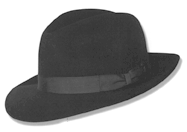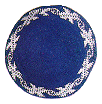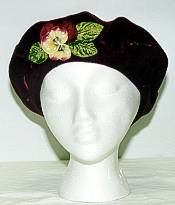Headcovering in Jewish Law
Headcovering in Jewish Law
There are two separate issues of covering the head in Judaism, one for men and one for women.
Men 
The basic halacha of covering the head for men is that it is forbidden to walk four cubits (appx 8 feet) with an uncovered head. (According to some authorities it is forbidden to go any distance at all without a head covering. It is even considered improper to sit in one's home with an uncovered head.)
It is also forbidden to say any prayer with the name of HASHEM or to study Torah without a head covering. Also men should wear a double head covering when davening (praying), this is accomplished by wearing a hat over your yarmulkah/kippa.
The Source
The source for not walking four cubits with the head uncovered is the statement in the Talmud that the mother of Rabbi Nachman bar Yitzchak would not allow him to go with his head uncovered for she said, "Cover your head in order that you should have the fear of heaven upon you." There is another statement that Rav Huna brei d'Rabbi Yehoshua would not go four cubits with his head uncovered.
Yarmulkahs/Kippot
Kippot, also known as Yarmulkahs(Yiddish),coverings usually worn by Jewish men all the time (even when sleeping)as a sign of reverence and humility to the awesome power of HASHEM (G-d).
Wearing a yarmulkah all the time also makes it alot easier by not to having to look for a yarmulkah when davening (praying) the three prayers a day, this is not the reason to wear them all time however, but just an added bonus.
 Black velvet yarmulkahs (kippot) are usually worn by those affiliating with the more observant communities.
Black velvet yarmulkahs (kippot) are usually worn by those affiliating with the more observant communities.
 The "modern observant" (i.e. Modern Orthodox)mainly wear "Kippah Srugah" (knit kippot) of solid or various
colors, and may or may not wear them all of the time, they are worn with any modest style and color of clothing.
The "modern observant" (i.e. Modern Orthodox)mainly wear "Kippah Srugah" (knit kippot) of solid or various
colors, and may or may not wear them all of the time, they are worn with any modest style and color of clothing.
Another basis given for this practice of headcovering is to avoid the customs of the non-Jews (i.e. pagans).
{NOTE:This does not apply to those that are non-Jewish born and have come into Yisroel, Messianic Ger'im who are non-Jewish Synagoge members who have been "grafted in", (as Rabbi Sha'ul haShaliach writes to the Roman believers in the 11th chapter of his letter to them) are part of something described as a "commonwealth" with Klal Yisroel (corperate Yisroel).
The term "goyim" is the same as saying "pagans", or "the nations that outside of Yisroel", "non-believers". Christian sects even use simliliar terms to say the same thing as the word "GOYEEM", they say...."secular", "the world", or "unsaved", for us as Jews to say "goyim" (goy-eem) it means the same thing.}
I have Sometimes gotten Hebrew Christians (who are Jews who have given up Biblical ways and left their calling as Jewish believers in order to join the church and live as gentiles) tell me that covering my head is against Moshiach because of something they read in a Christian Bible's MIStranslation..of 1 Corinthians 11:7
For a man indeed ought not to cover [his] head, forasmuch as he is the image and glory of God: but the woman is the glory of the man.
BUT, the word here for cover here means "to veil or cover one's self."....katakalupto {kat-ak-al-oop'-to} (scource: Strongs concordance, word #2619).
related words are ...#2596 kata {kat-ah'}, which means...1) down from, through out.
And #2572 kalupto {kal-oop'-to} ...1)which means. "down from", or "through out".
These were men that were cross dressing by wearing women's frilly veils, and Rabbi Shaul had to correct them by telling them to have tshuvah, to turn away from breaking Torah and instead dress like the men that G-d created them as.
Even if the requirement to cover the head at all times was not stated in the Torah, or in the Talmud, it is nevertheless an established Jewish custom and is binding on all Jewish men. The requirement to follow established religious customs is based upon the Biblical teaching, "Hear, my son, your Father's instruction, and do not forsake your Mother's Torah" (Mishlei - Proverbs 1:8). It is taught that "Father" in this verse refers to God, while "Mother" refers to the nation of Israel. "Your Mother's Torah" refers to religious customs which were established by the Jewish people. These have the status of Torah and are binding. The requirement of male headcovering is one such custom. (The requirement to cover one's head during prayer is discussed in Mesechta Sofrim 14:15.)
ALSO, in SHEMOS 28:40 (Exodus 28:40) (as just example, for it speaks of this in many other places)
Aharon benAsah katones asah abnet migba`ah asah kavod teferis. (I translated here without vowells , so bear with me, I'll check later in my Chumash)
ENGLISH TRANSLATION
And for Aaron's sons you will make coats, and you will make for them gartels (waist sashes), and headcoverings (turbans, or kippot) you will make for them, for glory and for beauty.
migba`ah {mig-baw-aw'} turban, head-gear, kippa, yarmulkah, bonnet, cap...ect.
(NOTE: Gartels??? getting kabalistic here,,,lol, Yeshua wears a gartel in Rev Ch, 2.)
Women 
Women who are, or have been married (widows and divorcees) are required to cover their hair. A woman who has never been married does not have to. Hats, sheitels (wigs), or tichels (which are sometimes called a snood) are worn depending on community, and their Rov, or Rebbe poskins (rules).
The Source
The Talmud in Kesuvos 72a states that the source for this prohibition is from The Torah She Biksav (The Written Torah)Bamidbar (Numbers) 5:18 which deals with the laws of a sotah - a suspected adulteress - and states, "The priest shall stand the adulteress woman before God and uncover her hair...". Rash'i (Rabbi Shlomo Yitchaki, 1040-1105, author of the primary commentary on the Talmud) provides two explanations for the Talmud's conclusion, one, that from the fact that she is punished midah kneged midah (measure for measure) for exposing her,a married woman's, hair to her paramour we see that this is prohibited and, two, from the fact that we expose her hair we see that under normal conditions a Jewish woman's hair should be covered.
© Copyright 1999 by
T.O.M.J. Beis
BACK TO ARTICLES INDEX


 Black velvet yarmulkahs (kippot) are usually worn by those affiliating with the more observant communities.
Black velvet yarmulkahs (kippot) are usually worn by those affiliating with the more observant communities. The "modern observant" (i.e. Modern Orthodox)mainly wear "Kippah Srugah" (knit kippot) of solid or various
colors, and may or may not wear them all of the time, they are worn with any modest style and color of clothing.
The "modern observant" (i.e. Modern Orthodox)mainly wear "Kippah Srugah" (knit kippot) of solid or various
colors, and may or may not wear them all of the time, they are worn with any modest style and color of clothing.
